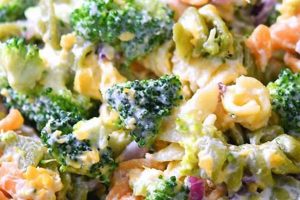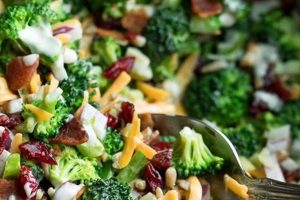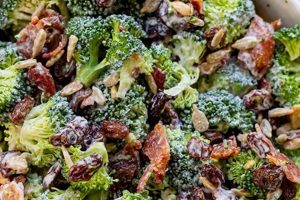This dish typically combines shredded broccoli, often with other vegetables like carrots and red cabbage, with crispy ramen noodles. A flavorful dressing, often made with a vinegar base, soy sauce, sesame oil, and ginger, binds the ingredients together. Variations may include additions like toasted nuts, seeds, dried cranberries, or mandarin oranges for added texture and flavor complexity. It can be served chilled as a light meal, a refreshing side dish, or a potluck contribution.
The combination of crunchy vegetables, crispy noodles, and a tangy dressing creates a satisfying textural and flavor profile. It offers a convenient way to incorporate more raw vegetables into one’s diet, providing essential vitamins, minerals, and fiber. Furthermore, the dish is often budget-friendly and adaptable to different dietary needs and preferences. Ingredients can be easily adjusted to accommodate gluten-free or vegan diets, for example.
The following sections will explore variations on this culinary theme, offering specific recipes and addressing common preparation questions. Techniques for achieving optimal noodle crispness and dressing emulsion will also be discussed.
Tips for a Perfect Broccoli Slaw and Ramen Noodle Salad
Preparation techniques greatly influence the final quality of this dish. Attention to detail ensures optimal texture and flavor.
Tip 1: Noodle Preparation: Achieve ultimate crispness by briefly frying the noodles before adding them to the salad. Remove the noodles from the package and discard the seasoning packet. Heat a small amount of oil in a pan over medium heat and fry the noodles until golden brown. Drain on paper towels to remove excess oil.
Tip 2: Broccoli Slaw Consistency: For a finely shredded slaw, a food processor fitted with a shredding disc offers efficiency. Alternatively, a sharp knife and careful slicing achieve similar results.
Tip 3: Dressing Emulsification: Whisk the dressing ingredients vigorously to create a smooth emulsion that coats the salad components evenly. Alternatively, a small blender or food processor can be utilized for this purpose.
Tip 4: Ingredient Customization: Adapt the recipe to individual preferences by adding other vegetables such as shredded carrots, bell peppers, or edamame. Toasted sesame seeds, slivered almonds, or chopped peanuts contribute additional texture.
Tip 5: Advance Preparation: While best served immediately, the salad components (excluding the noodles) can be prepared in advance and stored separately. Combine and dress the salad just before serving to maintain optimal texture.
Tip 6: Balancing Flavors: Adjust the dressing ingredients to achieve the desired balance of sweet, sour, and savory notes. A touch of honey or maple syrup can enhance sweetness, while additional vinegar or lime juice amplifies tartness.
Tip 7: Maintaining Crispness: To prevent the noodles from becoming soggy, add them to the salad just before serving. If making the salad ahead, store the noodles separately in an airtight container and toss them in just before serving.
By following these guidelines, one can elevate a simple salad to a culinary masterpiece. The resulting dish offers a delightful combination of flavors and textures.
The following section provides a complete recipe incorporating these techniques for a truly exceptional salad experience.
1. Fresh, crisp broccoli slaw
Fresh, crisp broccoli slaw forms the foundation of a successful broccoli slaw and ramen noodle salad. Its quality directly impacts the overall texture and flavor profile of the dish. Without a crisp base, the salad risks becoming soggy and unappetizing, especially when combined with a dressing. The slaw’s freshness contributes a vibrant, vegetal flavor that complements the other ingredients. Consider the difference between a salad made with freshly shredded broccoli and one using pre-packaged slaw that has been sitting in the refrigerator for several days. The former offers a satisfying crunch and bright flavor, while the latter may be limp and lackluster. This contrast underscores the importance of using fresh, crisp broccoli slaw.
Practical applications of this understanding are readily apparent in recipe development and execution. Recipes often emphasize selecting fresh broccoli and proper storage techniques to maintain crispness. Techniques such as chilling the slaw before combining it with other ingredients further enhance the desired texture. In a restaurant setting, the use of fresh, high-quality broccoli slaw distinguishes a superior salad from a mediocre one. Furthermore, understanding the role of fresh slaw allows for creative variations. Adding other crisp vegetables, such as shredded carrots or red cabbage, can further enhance the textural complexity while maintaining the foundational crispness provided by the broccoli slaw.
In conclusion, the importance of fresh, crisp broccoli slaw in this specific salad cannot be overstated. It serves as the backbone of the dish, providing essential texture and flavor. Prioritizing fresh ingredients and employing proper handling techniques ensures a satisfying culinary outcome. This principle extends beyond the specific recipe and highlights the broader significance of ingredient quality in any dish.
2. Crunchy ramen noodles
Crunchy ramen noodles constitute a critical element within a broccoli slaw and ramen noodle salad recipe, providing a textural counterpoint to the fresh vegetables and creamy dressing. Their preparation and inclusion significantly influence the overall sensory experience of the dish.
- Texture Enhancement:
The primary role of crunchy ramen noodles is to introduce a contrasting texture. The crispness offsets the softer textures of the slaw, creating a more dynamic and enjoyable mouthfeel. Consider the difference between a salad with soggy noodles and one with crisp noodles; the latter offers a more satisfying and multi-dimensional experience. This textural interplay elevates the dish beyond a simple combination of ingredients.
- Flavor Delivery:
While the noodles themselves offer a subtle savory flavor, their porous nature allows them to absorb and distribute the dressing throughout the salad. This ensures that every bite incorporates the intended flavor profile. The slight saltiness of the noodles complements the often sweet and tangy dressing, creating a balanced flavor combination.
- Preparation Methods:
Achieving optimal noodle crispness requires specific preparation techniques. Crushing the dry noodles before frying ensures even cooking and maximizes surface area for optimal crispness. Briefly frying them in oil until golden brown achieves the desired texture. Baking is an alternative method for achieving crispness while reducing oil consumption.
- Shelf Life and Storage:
Maintaining noodle crispness presents a challenge, especially when preparing the salad in advance. Storing the noodles separately in an airtight container and adding them just before serving helps preserve their texture. Exposure to moisture from the dressing or other salad components accelerates the softening process, diminishing the intended textural contrast.
The careful consideration of these facets demonstrates the significant role crunchy ramen noodles play in a successful broccoli slaw and ramen noodle salad recipe. Their contribution extends beyond mere texture; they influence flavor delivery and require specific preparation and storage considerations. Mastering the art of preparing crunchy ramen noodles elevates the overall dish, transforming it from a simple salad into a more complex and satisfying culinary creation.
3. Flavorful, balanced dressing
A flavorful, balanced dressing is paramount in a successful broccoli slaw and ramen noodle salad recipe. It serves as the unifying element, binding the diverse ingredients and transforming them into a cohesive, enjoyable dish. The dressing’s characteristics significantly influence the overall flavor profile and perceived quality of the salad.
- Flavor Complexity:
The dressing should offer a nuanced flavor profile that complements the inherent flavors of the broccoli slaw and ramen noodles. A simple vinaigrette, while functional, might lack the depth needed to elevate the dish. A more complex dressing, incorporating ingredients like ginger, garlic, sesame oil, and rice vinegar, provides layers of flavor that enhance the overall experience. This complexity prevents the salad from tasting bland or one-dimensional.
- Balance of Sweet, Sour, Salty, and Umami:
A well-balanced dressing harmonizes the four fundamental tastes. The sweetness might come from a touch of honey or sugar, while acidity from rice vinegar or lime juice provides the sour notes. Soy sauce or fish sauce contribute saltiness and umami, rounding out the flavor profile. Achieving this balance prevents any single taste from overpowering the others, creating a more harmonious and enjoyable culinary experience. For example, a dressing that is overly sweet can become cloying, while one that is excessively sour can be unpleasantly sharp.
- Texture and Viscosity:
The dressing’s texture and viscosity influence how it coats the salad components. A thin, watery dressing might not adequately adhere to the ingredients, resulting in uneven flavor distribution. Conversely, a dressing that is too thick can become heavy and mask the individual flavors of the slaw and noodles. The ideal dressing possesses a viscosity that allows it to cling lightly to the ingredients, ensuring a consistent flavor experience in every bite.
- Complementary Ingredients:
The dressing should complement any additional ingredients incorporated into the salad. For instance, if the salad includes toasted nuts or dried fruit, the dressing’s flavor profile should harmonize with these additions. A sesame-ginger dressing might pair well with toasted almonds and mandarin oranges, while a peanut dressing might complement shredded carrots and edamame. Careful consideration of these complementary flavors prevents clashes and ensures a cohesive final product.
A thoughtfully crafted dressing elevates the broccoli slaw and ramen noodle salad from a simple combination of ingredients to a well-rounded, flavorful dish. It provides complexity, balances flavors, and enhances the textural experience. The dressing’s role as a unifying element is crucial, demonstrating that a successful salad relies on more than just the quality of its individual components; it depends on the harmonious interplay of all elements, brought together by a flavorful, balanced dressing.
4. Optional add-ins (nuts, seeds)
Optional add-ins, such as nuts and seeds, play a crucial role in enhancing the broccoli slaw and ramen noodle salad recipe. These additions contribute significantly to the overall texture, flavor profile, and nutritional value of the dish. Their presence, while optional, offers an opportunity to elevate the salad from simple to sophisticated.
The primary benefit of incorporating nuts and seeds lies in the added textural complexity. The crunch of toasted almonds, cashews, or sunflower seeds contrasts with the softer textures of the slaw and noodles, creating a more dynamic and satisfying mouthfeel. This contrast prevents the salad from feeling monotonous and adds another layer of sensory enjoyment. For instance, the inclusion of slivered almonds introduces a delicate crispness, while pumpkin seeds offer a more robust crunch. Furthermore, the oils present in nuts and seeds contribute a richness and subtle flavor that complements the dressing and other ingredients.
From a nutritional perspective, nuts and seeds offer a valuable boost. They are rich in healthy fats, protein, fiber, and various vitamins and minerals. Adding these ingredients enhances the nutritional density of the salad, making it a more complete and satisfying meal. For example, sunflower seeds are a good source of vitamin E and selenium, while almonds provide magnesium and calcium. This nutritional enhancement aligns with the broader trend of incorporating more nutrient-rich foods into everyday diets.
The versatility of nuts and seeds allows for customization and creativity within the recipe. Different varieties offer distinct flavor profiles and textures, enabling adjustments based on personal preference or dietary restrictions. Toasted sesame seeds provide a nutty aroma and subtle crunch, while chopped walnuts offer a bolder, more assertive flavor. This adaptability allows the salad to be tailored to individual tastes and dietary needs, increasing its appeal to a wider audience. Moreover, the variety of available nuts and seeds ensures that the salad remains interesting and prevents flavor fatigue.
In conclusion, while labeled “optional,” nuts and seeds contribute significantly to the overall success of the broccoli slaw and ramen noodle salad recipe. Their inclusion enhances texture, elevates flavor, and boosts nutritional value. Understanding the impact of these additions allows for informed choices in recipe development and preparation, leading to a more satisfying and nutritious culinary experience.
5. Proper preparation technique
Proper preparation technique is inextricably linked to the success of a broccoli slaw and ramen noodle salad recipe. Technique influences texture, flavor development, and overall presentation, impacting the final dish’s perceived quality. Cause-and-effect relationships exist throughout the preparation process, demonstrating the direct impact of technique on the final outcome. For example, the crispness of the ramen noodles, a defining characteristic of this salad, relies heavily on the frying or baking technique employed. Overcooking leads to a soft, undesirable texture, while undercooking results in a tough, unappetizing product. Similarly, the manner in which the dressing is prepared and emulsified directly affects its ability to coat and adhere to the salad components. A poorly emulsified dressing separates, resulting in uneven flavor distribution and a less satisfying experience.
Consider the impact of knife skills on the broccoli slaw component. Uniformly thin slices create a pleasant texture and ensure even coating by the dressing. Conversely, unevenly chopped slaw leads to inconsistencies in texture and flavor distribution. Furthermore, timing plays a crucial role. Adding the dressing too early can cause the slaw to wilt and the noodles to soften, compromising the intended textural contrasts. These examples highlight the importance of proper preparation technique as an integral component of the recipe, directly impacting the dish’s sensory appeal.
The practical significance of this understanding lies in its ability to empower individuals to consistently produce high-quality results. By recognizing the cause-and-effect relationships between technique and outcome, one can anticipate and control the final product’s characteristics. This knowledge translates to a more satisfying culinary experience, whether in a home kitchen or a professional setting. Challenges may arise in replicating specific techniques, requiring practice and attention to detail. However, the rewards of mastering these techniques are evident in the final dish’s enhanced quality and enjoyment. This principle extends beyond the specific broccoli slaw and ramen noodle salad recipe, underscoring the broader importance of technique in all culinary endeavors.
Frequently Asked Questions
This section addresses common inquiries regarding broccoli slaw and ramen noodle salad recipes, offering practical solutions and clarifying potential points of confusion.
Question 1: How can one prevent the ramen noodles from becoming soggy?
The key to maintaining noodle crispness lies in adding them to the salad just before serving. Storing the noodles separately in an airtight container until serving time prevents them from absorbing moisture from the other ingredients. If preparing the salad in advance, combine all components except the noodles and add them just before serving.
Question 2: Can alternative dressings be used?
While the provided recipe offers a balanced flavor profile, alternative dressings can certainly be used. Experimentation is encouraged. Consider flavor pairings, ensuring the dressing complements the other ingredients. Peanut-based dressings, sesame-ginger variations, or even a simple citrus vinaigrette can provide interesting alternatives.
Question 3: What are suitable substitutions for broccoli slaw?
While broccoli slaw provides a specific texture and flavor, shredded cabbage, a combination of shredded vegetables (carrots, red cabbage, Brussels sprouts), or even chopped romaine lettuce can serve as substitutes. Keep in mind that these substitutions will alter the overall flavor and texture profile of the salad.
Question 4: Can this salad be made gluten-free?
Gluten-free ramen noodles are readily available in most supermarkets. Substituting these ensures a gluten-free version of the salad. Always verify that all other ingredients, including soy sauce and other condiments, are also certified gluten-free.
Question 5: How long can this salad be stored?
For optimal quality, consume the salad immediately after preparation, especially when the noodles have been added. If storing the salad without the noodles, it can be refrigerated for up to two days. However, some textural changes may occur.
Question 6: How can the nutritional value of the salad be increased?
Adding protein-rich ingredients like edamame, grilled chicken or tofu, or chickpeas enhances the nutritional value. Including a wider variety of vegetables, such as shredded carrots, bell peppers, or snap peas, also boosts vitamin and mineral content.
Addressing these common inquiries provides a comprehensive understanding of the recipe’s nuances and allows for informed adjustments based on individual preferences and dietary needs.
For further culinary exploration, consider the following section dedicated to variations on this popular salad theme.
Broccoli Slaw and Ramen Noodle Salad Recipe
Exploration of this recipe reveals a dish offering versatility and nutritional value. Emphasis on fresh ingredients, proper noodle preparation, and balanced dressing formulation contributes significantly to the final product. Textural interplay between crisp slaw, crunchy noodles, and a flavorful dressing creates a satisfying sensory experience. Optional additions, such as nuts and seeds, further enhance nutritional content and flavor complexity. Understanding the underlying principles governing each component allows for informed substitutions and adaptations based on individual dietary needs and preferences.
This dish represents more than a simple combination of ingredients; it embodies a culinary synergy achieved through thoughtful preparation and ingredient selection. Continued exploration of flavor profiles and textural variations offers opportunities for culinary innovation within this adaptable framework. Potential for customization and creative expression positions this recipe as a valuable addition to any culinary repertoire.






